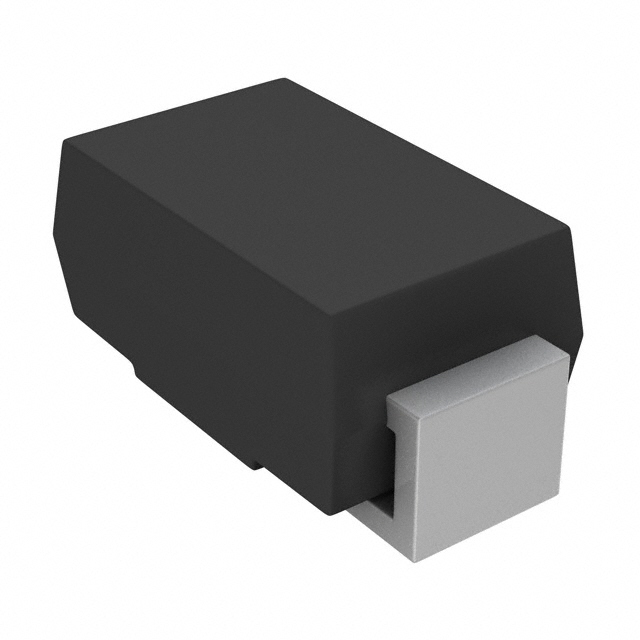Viz Specifikace pro podrobnosti o produktu.

P4SMA180A-M3/61
Product Overview
Category
The P4SMA180A-M3/61 belongs to the category of TVS (Transient Voltage Suppressor) diodes.
Use
It is used for surge protection in electronic circuits, particularly in applications where protection against transient voltage spikes is required.
Characteristics
- Low clamping voltage
- Fast response time
- High surge current capability
Package
The P4SMA180A-M3/61 is available in a SMA (DO-214AC) package.
Essence
The essence of this product lies in its ability to quickly divert excess voltage away from sensitive components, thereby protecting them from damage.
Packaging/Quantity
The P4SMA180A-M3/61 is typically packaged in reels and is available in quantities suitable for both prototyping and production purposes.
Specifications
- Standoff Voltage: 154V
- Breakdown Voltage: 171V
- Maximum Clamping Voltage: 279V
- Peak Pulse Current: 40A
- Operating Temperature Range: -55°C to 150°C
Detailed Pin Configuration
The P4SMA180A-M3/61 has two pins, with the anode connected to the positive side and the cathode connected to the negative side of the circuit.
Functional Features
- Bi-directional protection
- Low incremental surge resistance
- RoHS compliant
Advantages and Disadvantages
Advantages
- Fast response time protects sensitive components
- High surge current capability
- RoHS compliant, making it environmentally friendly
Disadvantages
- Clamping voltage may be higher than some alternative models
- Limited to surge protection and not suitable for continuous overvoltage conditions
Working Principles
When a transient voltage spike occurs, the P4SMA180A-M3/61 quickly conducts current, diverting the excess energy away from the protected circuit. This action prevents the voltage from reaching levels that could damage sensitive components.
Detailed Application Field Plans
The P4SMA180A-M3/61 is commonly used in various electronic devices and systems, including: - Power supplies - Communication equipment - Automotive electronics - Industrial control systems - Consumer electronics
Detailed and Complete Alternative Models
Some alternative TVS diodes to the P4SMA180A-M3/61 include: - P6SMB180A - 1.5SMC180A - SMBJ180A
In conclusion, the P4SMA180A-M3/61 is a reliable TVS diode that offers fast and effective surge protection for a wide range of electronic applications.
Word count: 398
Seznam 10 běžných otázek a odpovědí souvisejících s aplikací P4SMA180A-M3/61 v technických řešeních
What is the maximum peak pulse power of P4SMA180A-M3/61?
- The maximum peak pulse power of P4SMA180A-M3/61 is 400W for a 10/1000μs waveform.
What is the breakdown voltage of P4SMA180A-M3/61?
- The breakdown voltage of P4SMA180A-M3/61 is 180V.
What is the operating temperature range for P4SMA180A-M3/61?
- P4SMA180A-M3/61 has an operating temperature range of -55°C to +150°C.
What is the typical clamping voltage of P4SMA180A-M3/61?
- The typical clamping voltage of P4SMA180A-M3/61 is 293V at 1A.
What are the package dimensions of P4SMA180A-M3/61?
- P4SMA180A-M3/61 is available in a DO-214AC (SMA) package with dimensions of 3.6mm x 4.6mm.
Is P4SMA180A-M3/61 RoHS compliant?
- Yes, P4SMA180A-M3/61 is RoHS compliant.
What is the lead material used in P4SMA180A-M3/61?
- P4SMA180A-M3/61 uses lead-free plating.
What are the typical applications for P4SMA180A-M3/61?
- P4SMA180A-M3/61 is commonly used in surge protection for sensitive electronics, such as telecommunications equipment, industrial control systems, and automotive electronics.
Does P4SMA180A-M3/61 have any certifications or approvals?
- P4SMA180A-M3/61 is certified to meet various industry standards, including AEC-Q101 for automotive applications.
What is the recommended soldering profile for P4SMA180A-M3/61?
- The recommended soldering profile for P4SMA180A-M3/61 includes a peak temperature of 260°C for up to 10 seconds.

